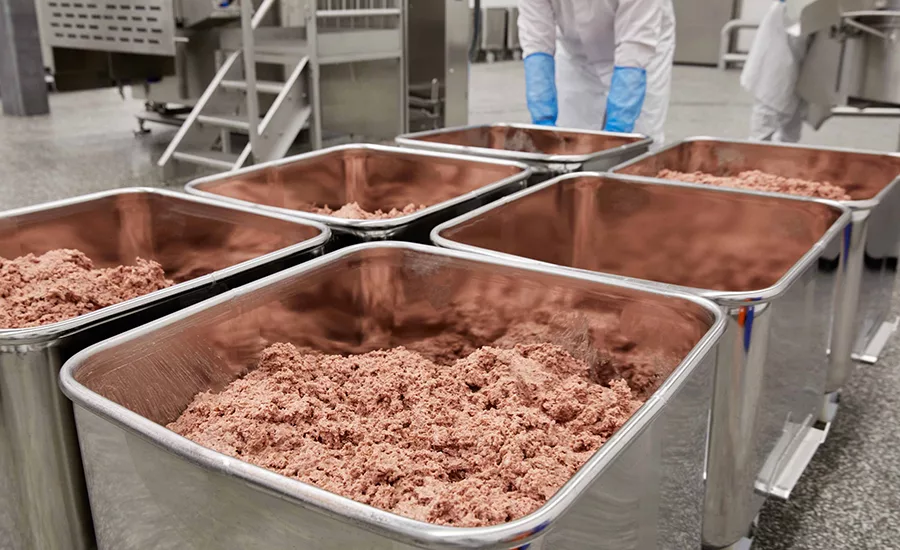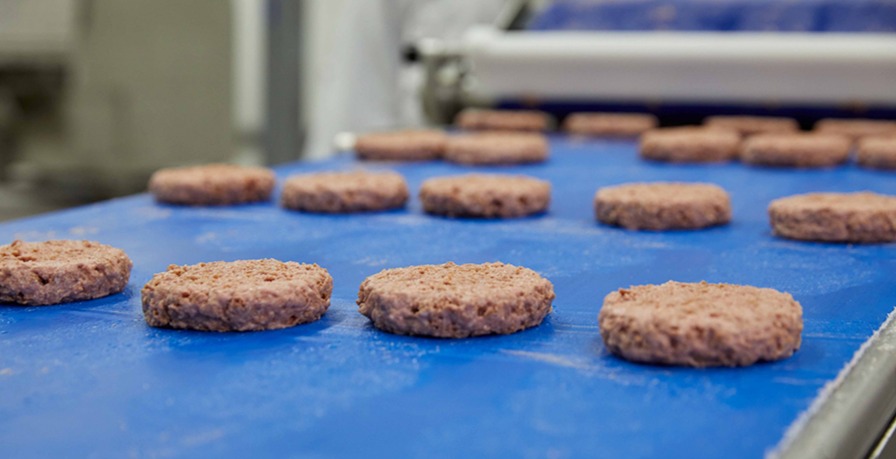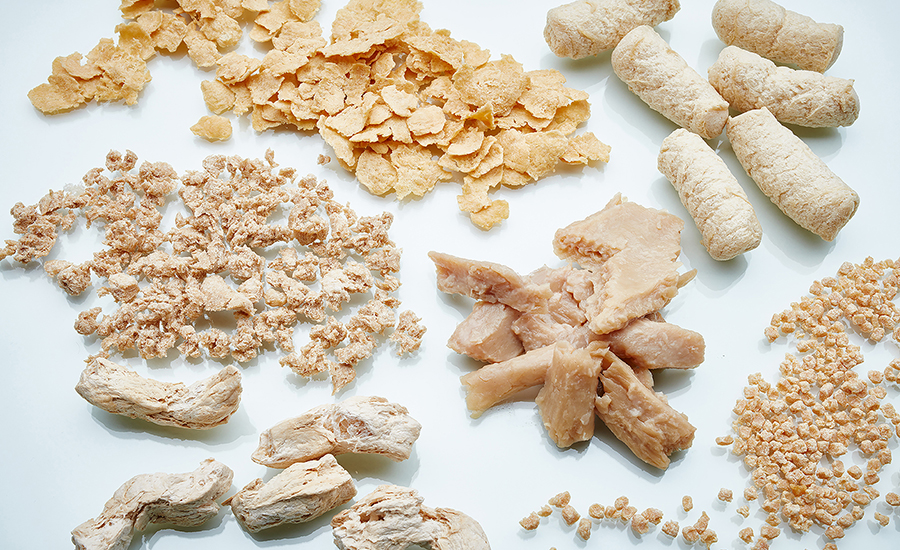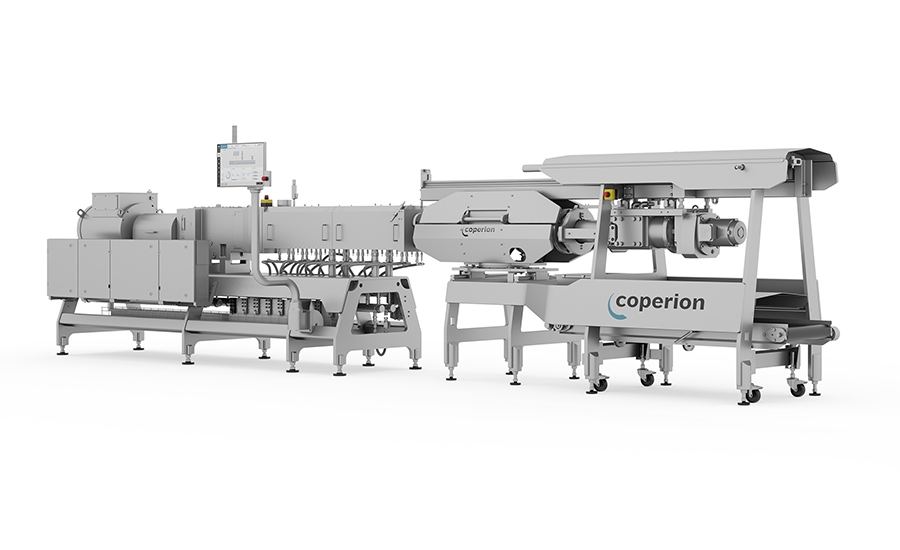Comparing Production Processes for Alternative and Animal Protein
When it comes to production, similarities exist among alternative and animal protein processes, but several differences occur, particularly around operational footprint, equipment, and water and energy usage.

Operational differences between plant-based proteins and animal-based proteins may be subtle on the surface, but are significant the deeper you go. Image courtesy of Beyond Meat
As an umbrella term, alternative protein covers a variety of products and processes—including plant-based offerings, cellular agriculture and precision fermentation, and even insect-based ingredients.
This global market, projected to reach $25.2 billion in 2029 by research firm MarketsandMarkets, is continuing to improve, particularly since the COVID-19 pandemic, says John Sheehy, global business development manager-alternative proteins, Coperion, an operating company of Hillenbrand.
“The quality of the product, the nutritional value of the product—you’re just seeing it increase monthly,” he says. “They’re coming out with more and more functional ingredients that are helping the overall process to produce better meats and better technology.”
When it comes to production, similarities exist among alternative and animal protein processes, but several differences occur, particularly around operational footprint, equipment, and water and energy usage.
Facility Layout
Shalima Sreenath, who currently serves as head of downstream processing at Cellibre but has experience with Beyond Meat and Kerry Ingredients, noted there are similarities in facility layout between plant-based protein processing and traditional protein processing.
“For plant-based protein, the initial part is very similar to any other food processing and the final part is very similar to animal processing,” she says.
Specifically, plant-based processing often begins with washing, milling, grinding and extraction of protein from peas, soy and other raw materials. Meanwhile, with traditional protein, processing begins with animal inspection, slaughtering, cleaning and deboning, Sreenath says.
For cellular agriculture, the process begins with receiving raw materials such as glucose and amino acids to support production. Before they’re introduced to bioreactors, microorganisms also need special attention.
“You would need a clean room for strain propagation, strain handling and handling that genetic engineering part of it. That would require much more control,” Sreenath says.
As product moves through the process, parallels emerge, particularly when it comes to cooking, packaging and refrigerating plant-based and animal protein products. However, for cell-based processes, there are important steps for harvesting final product.

“Most of the focus I think is on generating it in the tank, but then there is a whole new downstream process which I think people seldom realize,” Sreenath says. “It's very specific toward what you're trying to recover. Some of the operations I can say are interchangeable. For example, most of the time you would go to centrifugation or filtration right after the fermentation is done. That would be very common among the cell-based processes. But then it depends on what yields you get from there, what the purity is and what more separation you need to do as far as actually harvesting the stuff from the tank.”
Plant designs must also include plans for waste management, and animal-based processes often have greater needs than plant-based processes, Sreenath says.
“You would need to have odor control, any kind of odor monitoring and waste release. You need to have proper waste management plans, whereas in plant-based, it’s a little less stringent than that. It’s more like normal food processing, versus animal,” she says. “For cellular agriculture, it's a little tricky because there would be engineered organisms in there. You would need to make sure, based on the city guidelines, that it’s properly handled.”
Sreenath notes these processes require different operational footprints, with cellular agriculture requiring the least amount of space and traditional animal protein requiring the most amount of space—largely because of animal receiving, inspection and quarantine, in addition to processing.
“The raw material handling area is quite huge versus plant protein,” Sreenath says. “(The plant materials) would come in totes and it can be used right away. Going through the slaughtering and deboning process would require more space, whereas for plant-based protein, once the grinding and the extraction is done, you are working with a really small quantity of material.”
Stringent requirements also necessitate different considerations for managing the flow of employees to avoid contamination.
“To the animal processing facilities I've been to, there are separate break rooms for people working on the raw side versus people working on the cooked side, so that's another thing that adds into the footprint,” Sreenath says. “In a plant processing facility, you would have stricter standards as we would go through to the cooked side, but it's like putting on like an additional layer of PPE versus keeping it totally separate.”
Water, Energy and Air Usage
Processes for animal and plant-based protein, as well as cellular agriculture, all require water, but specific uses slightly vary.
“If you look at the process flow for animal protein and plant protein, in the animal protein processing facility, there is a significantly larger portion of the water being used mainly because you have to wash away the blood in the slaughterhouses,” Sreenath says. “Whereas in a plant protein facility, it's very similar to other vegetable processing where there is some washing required, but then once you extract it, it goes through a cooking process. The water usage is much less.”
For cellular processes, water often comprises the majority of the base mixture, but it’s also required for steam, Sreenath says.
“Steam would be required for sterilizing the vessels, because it's all aseptic processing,” she says. “And then water being added in the tank. The majority of your media is water. Then you would use water for CIP.”
Refrigeration is a key driver for energy usage across all three processes, but it’s especially important for animal protein processing, Sreenath says.
“From an engineering standpoint, you would require refrigeration, so ammonia compressors and all that,” she says. “The whole facility would have to be refrigerated. For plant protein, I think for the initial part you don't really need to be refrigerated. You can do a normal food processing environment, but then the final forming and packaging can be refrigerated.”
Sreenath also points to the importance of air, whether it involves using positive pressure to avoid contamination, or to support organisms in cell-based processes.
“For air, it actually depends on the organism,” she says. “If it's a highly aerobic organism, then you would need to keep it aerated, so at that point, there is a lot of air being used. For downstream processing, air would be used for actuating valves.”

Equipment
Cell-based processes rely on bioreactors, whereas plant-based and animal-based processes can use standard food production equipment available on the market.
“For cell-based, it's very specialized pieces of equipment you would need, whereas plant-based protein, you could technically qualify multiple processes with the same equipment, but for cell-based, it's very specific,” Sreenath says.
However, Coperion’s Sheehy says equipment for plant-based processes have been somewhat modified from meat processing equipment.
“We can take that equipment used in animal protein production, but how can we further customize that equipment for the alternative protein industry? That is going to take a little while, as well,” he says. “You’re seeing all these animal protein machine manufacturers—now that they see a market—adjusting that equipment specifically for this space, which is only going to help in the long term.”
Specifically, Coperion’s ZSK extruding system features a smaller operational footprint and is compatible with the new MEGAtex S7 and R90 cooling dies to support production of high moisture meat analogues (HMMA). Sheehy adds the size and shape of extruded products can vary, and throughput with MEGAtex cooling dies can reach 500 kg per hour.
“We’re going to continuously look to improve our equipment, we’re continuously looking to work with scientists and innovators in the market,” Sheehy says.

What’s Next
As plant-based products continue to hit the mainstream, they will feature better nutritional profiles and approach a similar price point as animal products, Sheehy says.
For example, Beyond Meat recently introduced its fourth generation of Beyond Sausage, Beyond Burger and Beyond Beef. The sausage features 17 grams of protein per serving, while the burger and beef products feature 21 grams of protein. Saturated fat content was reduced to 2 grams per serving in all products, thanks to avocado oil.
Beyond Meat also recently introduced Beyond Sun Sausage, which is not intended to replicate beef, pork or poultry and is instead meant to be its own protein option. These products feature ingredients from vegetables, fruits and legumes, including spinach, bell peppers, yellow peas, brown rice, red lentils and fava beans.
“Now you’re seeing these third, fourth, fifth generation products coming out, and they are much better for you than traditional meats—a lot less saturated fats, cholesterol levels and everything else—and you’re starting to approach price parity,” Sheehy says.
Both Sreenath and Sheehy pointed to the possibility of using cell-based processes to develop specific ingredients and combining them with plant-based protein to create products with elevated flavor and nutrition profiles.
Sreenath cited Impossible Foods, which uses genetically engineered yeast to develop heme, a molecule that gives meat its meaty flavor.
“You’re seeing a lot too on the fermentation side, using precision fermentation to develop much more functional ingredients,” Sheehy says. “As the biotechnology portion of the alternative protein market increases the functionality of the ingredients—I think that’s a big reason why you’re seeing the nutritional aspects of some of these products come up.”
Looking for a reprint of this article?
From high-res PDFs to custom plaques, order your copy today!








